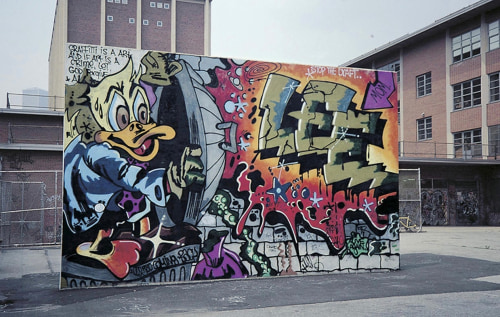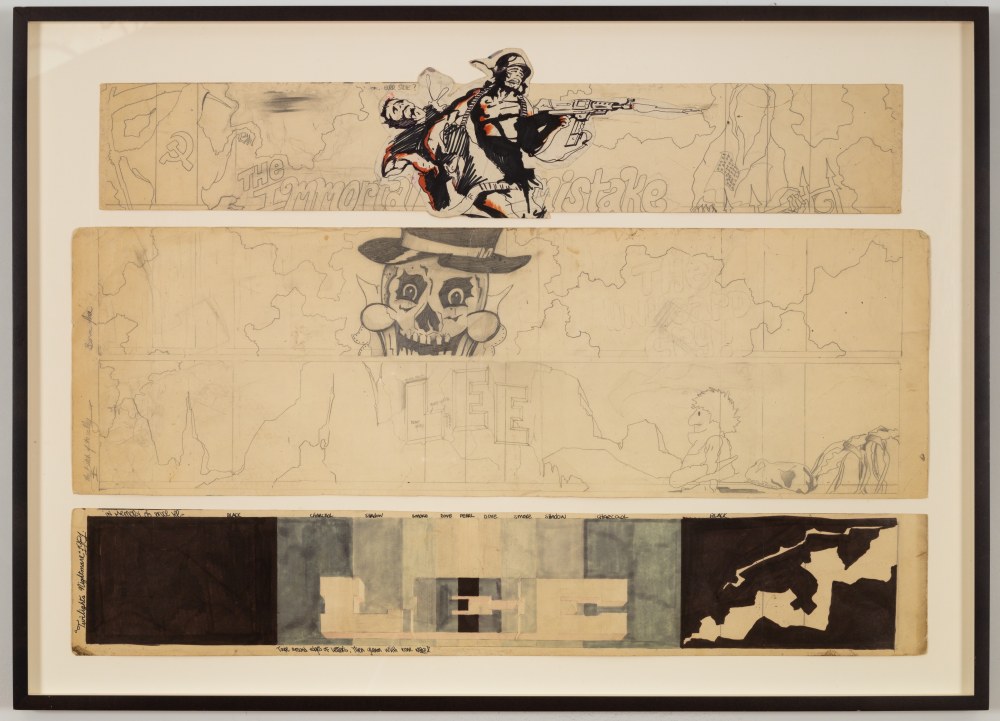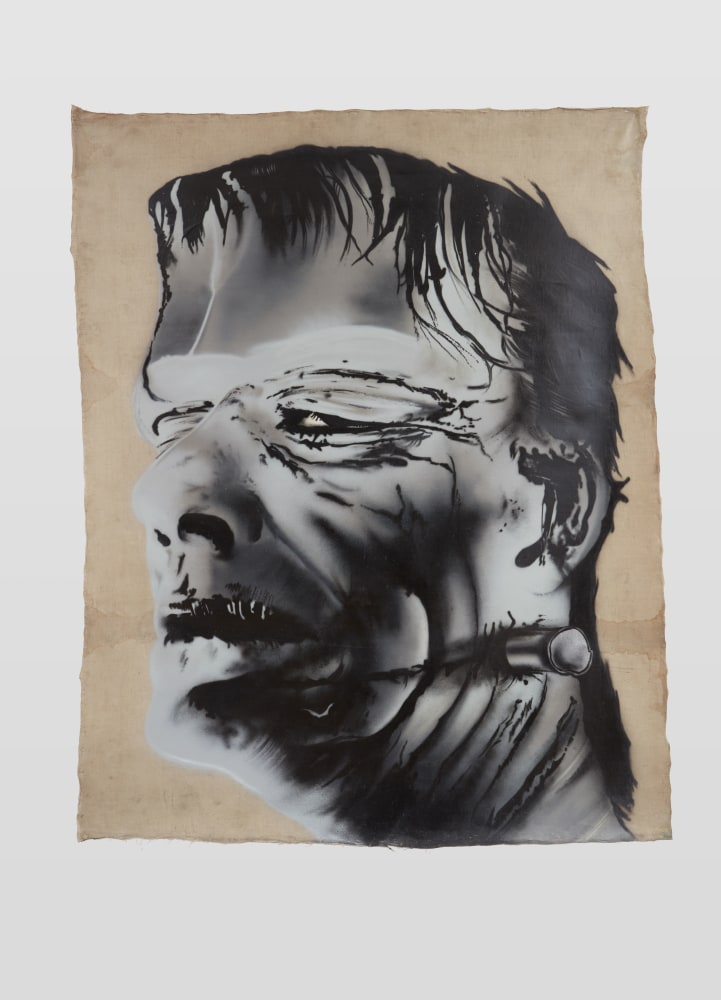“The 2, 4, and 5 subway lines were focused on and visually narrated by just a few talented groups,” Lee Quiñones (b. 1960, Ponce, Puerto Rico) has explained his early days writing graffiti. Quiñones, among others, innovated the practice by expanding small-scale throw-ups into large formats; when interviewed he often acknowledges work of fellow writers BLADE (Steven Ogburn) from Co-Op City in the Bronx and CLIFF 159 from Harlem, active in the mid-1970s[1]. Their compositions soon outfitted entire subway cars. Claiming space while countering municipal rhetoric have been part of Quiñones’ artistic practice since.
In his early work, Quiñones consistently deployed his first name, Lee, just the name Lee, in large block letters. Rather than a tag, made with sprayed line, or a throw-up, embellished with volume and shadow, Quiñones sited Lee within painted scenography. For instance, in Soul Train (1975), photographed by the artist, “LEE” holds steady amid a depiction of a steam engine heaving air (fig. 1). The conjured sounds of the titular variety show—music by Labelle, Marvin Gaye, and Elton John—elevate a breathless car and make it Quiñones’ own (fig. 2). Elsewhere, as in Window Down Burner (1978), the artist transfigured LEE’s letters in early wild style by exaggerating the swash of the E’s, twisting the serifs so that they wrap through one another. The artist positioned it amid a yellow and orange backdrop. The shading (and the title) divert the afterimages of landlord abandonment that marked the city then[2].
These scenes traveled. Quiñones and his fellow makers intentionally harnessed the train’s motion, a choice that was as practical as it was aesthetic. As a mode of presentation, the subway physically carried their work across neighborhood lines and conceptually propelled it into animation. These metal cars rattled LEE along the northeastern flank of Manhattan, from Bowling Green through Midtown to the Upper East Side and 125th Street in Harlem, passing it between increasingly disjointed communities and reverberating it beneath their foundations.
Quiñones’ strategy to annex publically-owned structures for his artworks went hand in hand with political movements afoot in his home neighborhood of the Lower East Side. During the 1970s, city and federal legislation withdrew social services. At the same time real estate associations campaigned to convert rent-controlled housing into cooperatively owned buildings[3]. Kellie Jones has explained the federal policy as the “dismantling of the urban neighborhood” nationwide[4]. In addition, Rosalyn Deutsche has reasoned New York development as a process of mass eviction that pushed out blue-collar workers to produce homelessness in New York City[5]. Bracing amidst displacement, small groups organized to shore up neighborhood stability in the Lower East Side. These residents secured and rehabilitated city-owned buildings, mostly without permissions, restoring tenancy and services to them[6].
Quiñones grew up during the pressures of rearrangement in the Lower East Side. We might ask how he, a young artist already sophisticated in spatial movement and communicating within it, responded to the revaluation of property in his community. How might we read his art in conjunction with the complexities of city-sanctioned development and the grassroots defenses against it?

Lee Quiñones, Howard the Duck, 1978, Handball wall mural, 30 x 15 feet. Courtesy of the artist and Ross+Kramer Gallery, New York
In 1978, when Ed Koch advanced into city office through a law and order platform, Quiñones transitioned to using stationary supports such as handball courts. The artist trained his focus specifically on the court of Henry Street near Seward Park. Viewers and their perambulations activated his novel mural campaigns: “I wanted to go from something that was moving to an object that was not,” he says, “so now people were coming to the object where it was standing, and the work was open to analysis.”[7] His first such effort (fig. 3), Howard the Duck, claimed the entire free-standing wall, extending twenty feet wide and sixteen feet tall. The piece featured the comic character poised on top of a trash can, gripping the lid for cover. The upper left corner uttered an appeal: “Graffiti Is an Art and If Art Is a Crime, Let God Forgive All.” In this, as well as campaigns featuring large comic figures, the artist sourced the fictional characters to offer viewers a “protective mascot in the midst of the tragedy.”[8]
Understanding the backstory of the Marvel comic Howard the Duck helps explain Quiñones’ re-use of it.[9] The character, an alien, abducted to Earth, was “Trapped in a World He Never Made,” per the 1970s comic book, is a message that conveys a body made strange by dominant order. Howard is required to move within a space he did not conceive, which did not serve him: he seeks shelter, overcomes illness, works as a dishwasher and cab driver-- physically demanding jobs, and must defeat foes amidst his odyssey to return home. The storylines, generated by Steve Gerber and Val Mayeric, featured Howard as an ambivalent hero—both a criminal arrested for disturbing the peace and an unlikely champion chronicled as protecting the world during his misadventures.[10]
Quiñones’ composition deliberately converted a 1977 scenario showing Howard cowering in the face of Sudd, “the scrubbing bubble that walks like a man.”[11] In the mural, Howard assumes the posture of the original, but rather than fending off cleanup, he braces against LEE. The letters burst forth from and seemingly fracture the brick backdrop. Quiñones adopts the palette of the source material: red, orange, and yellow halo the moniker and complements the letters, sprayed in green. Though the “cracks” in the typeface suggest erosion, the angle and curve are buoyant. Standing behind this innovation is the onomatopoeia used by comic writers to enliven illustrations. LEE joins the grammar of sound-words—Splat!, Kapow!, Yoink!, Psssssst—that enhance action and deviate the constriction of formal language. The name floats, suspended between the depicted and the physical wall, an effect assisted by a drop shadow and diegetic sound.
Quiñones’ Howard the Duck alludes to foiling erasure. The cleaning agents coalescing into a human form, of the source material, conjure up a reference to official efforts to soap down the city. LEE’s momentary gain countered the concurrent municipal protocol of cleansing public spaces of writer’s unwanted traces. Art historian Claire Grace has explained graffiti exemplified both a continued protest against the recoding of public infrastructure under Koch and the refusal of city governance to affirm voices of the writers. The anti-graffiti position heightened under the mayor, Grace explains. As a cosmetic policy, it was inseparable from the remaking of the city “in the image of neoliberalism by prioritizing the outward appearance of order.”[12] By replacing the concoction of bleach, borax, and enzyme, LEE symbolically defeats the lathering white detergent of city agents. Yet, as Grace notes, city-generated media campaigns framed graffiti as the cause of rundown (rather than a means of beautification or an enunciation against mismanagement).[13] The continued conflation of graffiti practice with crime rates worked to assail the writers as antagonistic opponents and aggressively muted their messaging.[14] Conditions of racism, entwined with police brutality, further encoded the increasingly punitive stance against graffiti writers.[15]

Lee Quiñones, Whole car cluster #2, 1980–1983, Alcohol marker, ink and pencil on poster board card stock, 20 x 28 1/2 in. Courtesy Ross+Kramer Gallery, New York
By 1980, Quiñones increasingly made his subway compositions into overt retorts to municipal rhetoric. Energy from My Soul (1980) questioned city positioning publically, as captured by photojournalist Martha Cooper in Subway Art. The text at the lower left explained: “There Was Once A Time When The Lexington Was A Beautiful Line When Children Of The Ghetto Expressed With Art, Not With Crime. But Then As Evolution Past, The Transits Buffing Did Its Blast. And Now The Trains Look Like Rusted Trash, Now We Wonder If Graffiti Will Ever Last…????????” The statement divided graffiti as a practice against criminal activity by invoking artistry. Quiñones went so far as to suggest writing as transformative, an ameliorative to continued neglect of the transit system and its users. The short phrase also clarifies the futility of buffing the train artworks. As the Transit Authority painted over graffiti, blot outs only heightened the disorder that the administration obscured.
In exhibitions throughout the 1980s, Quiñones worked intersectionally, bringing graffiti into the rarefied commercial art world, the alternative venues adjacent to it, as well as to more popular audiences.[16] Quiñones also maintained the importance of place on the Lower East Side. Turning to Martin Wong’s Attorney Street (Handball Court with Poem by Piñero) (1982–84) gives a helpful perspective on social relations in the community at that moment. Wong’s painting preserves the claim of a handball court by multiple graffiti writers. An expansive apartment block backs the luster of the newest and more elaborate throw-ups. The façade also reveals some windows adorned with single white curtains or beige rolling blinds, while others are bare and blacked out. In the sky, Wong lettered Piñero’s words to relay the everyday encounters with incarceration and addiction as well as to toast younger urban poets.[17] The nods give an idea of artistic genealogy and of the survival asserted there.
Like his colleague and friend Martin Wong, Quiñones continued to respond to the systemic violence those in the neighborhood faced, as exemplified by his contribution to Your House Is Mine (1993). Conceived as “an act of resistance,” the publication assembled posters made by artists and collectives including Wong, Stash Two, Missing Foundation, Lady Pink, ACT UP, and more which testified against their deletion from the city.[18] The 1993 book release punctuated the housing protests in the Lower East Side and anticipated the actions (and eventual lawsuits) of squatters against the decrees that tied their residences to redevelopment.[19] The volume had been generated by an arts collective and venue, Bullet Space. The organizers had adopted homesteading practices in 1984 by occupying 292 East Third Street without formal city sanction.[20] Your House Is Mine reflects the ethos of the space: the collection doubled as a street project, distributing the placards for use in and beyond the Lower East Side.[21]

Lee Quiñones, The Creation of Three Mile, 1989, Triptych, Spray paint on linen, 182 x 120 inches. Courtesy of the artist and Ross+Kramer Gallery, New York
Quiñones crafted his poster, Century of the Wind (fig. 4), in 1989 by sourcing the words of Eduardo Galeano, an Uruguayan writer and committed socialist. Short vignettes from Galeano’s Memory of Fire (1985–88) array around the center page. Here Quiñones illustrated the head of Frankenstein’s monster. The green bust interrelates the descriptions of the city with an image bound to reanimated body parts and the revived dead. Quiñones also added an entry that echoes the tone of headlines: “The cities secret neighborhood enhancement, the million dollar ‘window life’ panels painted on vacant buildings was a crude defacement saying don’t worry.”[22] The statement (with its pointed allusions to cosmetic improvement as a signal of city-managed redevelopment) amplifies the dissenting artists’ concern. These municipal-issued decals, not the artists’ protests, are the offense, Century of the Wind argues.
Photo documentation shows Quiñones with Your House Is Mine on May 4, 1992, at Exit Art, an alternative art space in SoHo. He leans, poised, over a microphone, backed by the paste-ups. Before he spoke, he had already ensured one recall LEE hurtling by. It resounds beyond a fleeting recollection—between neighborhoods and art communities—averting official attempts at dislocation.
Notes
[1] The word “writing” here notes graffiti as a broader practice. Tim Drescher explains: “All spray-can practitioners are known as ‘writers,’ regardless of whether they are putting words or images or some combination of the two. This terminology obviously refers to the origins of the form, but it does not suggest recent extension far beyond mere words.” Tim Drescher, “Graffiti Language: An Interview with Jim Prigoff,” Public Art Review 6, no. 2 (Spring–Summer 1995): 23.
[2] A burner is an elaborate piece, but the term “burnout” is also prevalent in the oral histories collected by Amy Starecheski. Residents describe building failure due to landlord abandonment, as “building burnout.” Arson (including the fires caused by faulty gas lines and exploding boilers) enabled owners to profit from insurance payouts when they no longer gained from renters. See Amy Starecheski, Ours to Lose: When Squatters Became Homeowners in New York City (Chicago: University of Chicago Press, 2016).
[3] Benjamin Holzman, “‘I Am Not Co-Op!’ The Struggle over Middle-Class Housing in 1970s New York,” Journal of Urban History 43, no. 6 (2017): 864–85.
[4] Kellie Jones, South of Pico (Durham, N.C: Duke University Press, 2017), 13.
[5] Rosalyn Deutsche, “Homeless Projection and the Site of Urban ‘Revitalization,’” in Evictions: Art and Spatial Politics (Cambridge, MA: MIT Press, 1996), 3–49.
[6] Sarah Farley, a civil rights activist and community organizer, helmed the homesteading effort. She served as the leader of the organization L.A.N.D. Through her counsel, squatters sealed buildings on 13th Street and 6th Street, and the movement continued into the 1980s. See Starecheski, Ours to Lose, 42–74.
[7] Quiñones, “The Birth of Wild Style,” 47.
[8] “Lee Quiñones,” Beyond the Streets exhibition website: https://beyondthestreets.com/pages/lee-quinones.
[9] Disidentification is a strategy that José Esteban Muñoz asserts as a world-making project. Using Basquiat as his case study, Muñoz argues the artist invoked Warhol and Batman to charge his work and transform the sources. He explains,“Disidentification for the minority subject is a mode of recycling or re-forming an object that has already been invested with powerful energy.” The method intervenes in the patterns that marginalize identities. José Esteban Muñoz, “Famous and Dandy like B. ’n’ Andy: Race, Pop, and Basquiat,” in Disidentifications: Queers of Color and the Performance of Politics (Minneapolis: University of Minnesota Press, 1999), 39, 51.
[10] Howard mostly lives itinerantly though this drawn-out odyssey; as he is propelled by the urgency to “return home,” his foes often demand he “clean up his act.”
[11] I am indebted to Kevin Foakes for publishing the Howard the Duck cover sourced by Quiñones. Kevin Foakes, “Howard the Duck Graffiti Originals,” dj food (blog), March 20, 2022, https://www.djfood.org/howard-the-duck-graffiti-originals/.
[12] Claire Grace, Art Demonstration (Cambridge, MA: MIT Press, 2022), 206.
[13] Also indicated by Style Wars, directed by Tony Silver (Public Broadcasting Service, 1983), 1:10:00.
[14] Ibid.
[15] Joe Austin quoted in Grace, Art Demonstration, 207. For a historical account see Joe Austin, Taking the Train: How Graffiti Art Became an Urban Crisis in New York City (New York: Columbia University Press, 2001).
[16] The work of Quiñones was exhibited by galleries affiliated with the commercial art market (Barbara Gladstone in 1982) and joined to exhibitions considered in opposition to it (The Times Square Show in 1980) as well as adjacent to it (Fun Gallery, 1982). His painting was also featured in Blondie’s music video for “Rapture” (1980) and in the film Wild Style (1983) in which he performed, directed by Charlie Ahearn.
[17] Yasmin Ramirez, “La Vida: The Life and Writings of Miguel Piñero in the Art of Martin Wong,” in Sweet oblivion: the urban landscape of Martin Wong, ed. Amy Scholder (New York: Rizzoli, 1998), 38-39.
[18] See Kostas Gounis and Andrew Catrucci “Disappearances” in newspaper edition, Andrew Castrucci, Nadia Coen, ed., Your house is mine, 1988-1992 an act of resistance (New York: Bullet Space, 1992), 3.
[19] The initial compromise, the 50/50 Cross Subsidy Plan, allowed for-profit development with a provision for limited low-income housing. As Starecheski explains, it also described some of the recently claimed residences as vacant, which rendered these properties vulnerable to development: renovation and re-occupation. Protests occurred initially in Tompkins Square Park between 1988 and 1989. See Starecheski, Ours to Lose, 88–89. Actions targeting the community board swelled in fall 1994, as reported in Marvin Howe, “13th Street Plan Clears Latest Hurdle; Squatters Vow a War,” New York Times, October 2, 1994, sec. 13, p. 9. For more about Your House Is Mine see Alan Moore with Jim Cornwell, “Local History: The Art of Battle for Bohemia in New York,” in Alternative Art New York 1965 -1985: a cultural politics book for the Social Text Collective, ed. Julie Ault (New York: Drawing Center, 1996), 351-352.
[20] Starecheski clarifies between homesteading and the adoption of homesteading, see Ours to Lose, 42-118. Bullet Space eventually secured ownership of its once-abandoned building by arguing and winning a lawsuit over adverse possession. The agreement reached with the city required that the building remain affordable housing. See Starecheski, Ours to Lose, 151–53.
[21] As chronicled by Julia Ault, “Bullet Space also housed a print shop that produced broadsides and newspapers denouncing gentrification and structural homelessness.” See Alternative Art New York 1965-1985 (New York: The Drawing Center, 2002), 75.
[22] Paul Catrucci, Miguel Aglarin, Andrew Castrucci, and Nadia Coën, ed. Your House Is Mine: An Act of Resistance (New York: Bullet Space, 1993).